The classical Dual Labeled Probes are hydrolysis probes that are designed to increase the specificity of quantitative PCR.
Dual Labeled Probes used in quantitative real-time PCR systems take advantage of the 5' -> 3' exonuclease activity of Taq polymerase. They consist of a fluorophore at the 5'-end and a 3' quencher which anneals between the PCR primers.
During the extension phase of PCR, the 5' -> 3' exonuclease activity of Taq polymerase cleaves the fluorescent reporter from the probe. The amount of free reporter accumulates as the number of PCR cycles increases. The fluorescent signal from the free reporter is measured in real-time and allows the quantification of the target sequence.
Available dye-quencher combinations:
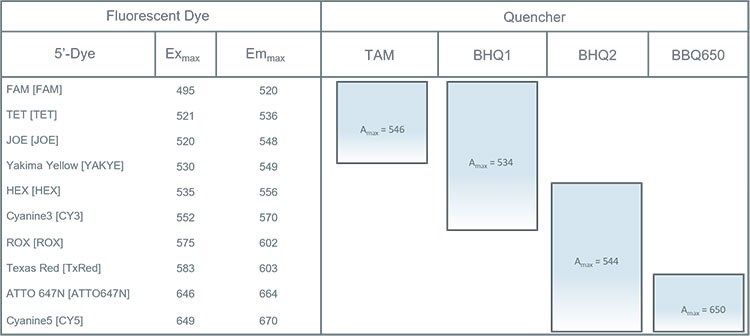
Product specifications:
- Available synthesis scales: 0.01 - 1.0 µmol
- Probe lengths: 10 - 40 bases (wobbles non-defined ratio possible)
- HPLC purified by default
- TAT: 3 – 5 working days (1.0 µmol scale takes longer)
Minimum and average yields:
|
Synthesis scale
|
0.01 µmol
|
0.05 µmol
|
0.2 µmol
|
1.0 µmol
|
| Min. / Avg. Yield [OD] |
1 / 3 |
1.5 / 5 |
3 / 8 |
6 / 15 |
MGB Probes provided by Eurofins Genomics stabilise probe-target hybridisation and increase melting temperature.
Eurofins Genomics MGB Probes incorporate a 5’ fluorescent dye and the 3’ Eclipse quencher (EQ) attached to the minor groove binder (MGB) molecule.
Probes containing a MGB molecule form an extremely stable duplex which gives the probe a significant increase in the melting temperature (Tm). It is therefore possible to use shorter probes (down to 13 bases) in real-time PCR compared to conventional dual-labeled probes.
MGB Probes for gene expression analysis & SNP genotyping
The double-stranded DNA is denatured by raising the temperature. At this point the fluorescent dye of the probe is quenched by the MGB-Eclipse quencher.
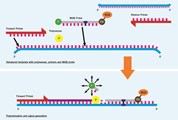
By decreasing the temperature the PCR primers and MGB probe anneal to their specific target sequence. Allelic discrimination is achieved by the selective annealing of the MGB probes (Figure 2).
The taq polymerase synthesises a complementary DNA strand using the PCR primers and template as a guide. When the polymerase reaches the MGB probe its 5´nuclease activity cleaves the probe and separates the fluorescent dye from the non-fluorescent quencher.
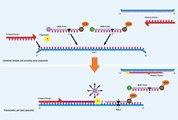
Available dye-quencher combinations:
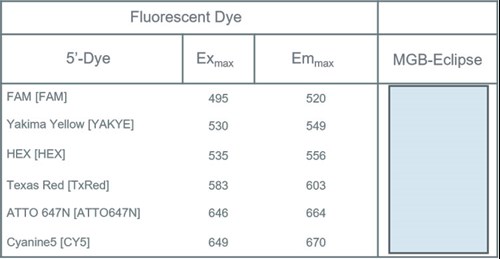
Product specifications:
- Selectable delivered quantities of 5 nmol, 20 nmol and 40 nmol
- Probe lengths: 10 - 40 bases
- HPLC purified by default
- TAT: 3 – 5 working days
LocNA Probes facilitate the optimal design of highly specific, shorter probes.
LocNA probes contain Locked Nucleic Acid (LNA) bases which improve the stability and performance of qPCR assays. These modified bases provide a 2'-O, 4'-C methylene bridge which effectively "locks" the 2' oxygen to the 4' carbon. LocNA probes are the optimal choice when designing highly specific, shorter probes with challenging target sequences.
Available dye-quencher combinations:
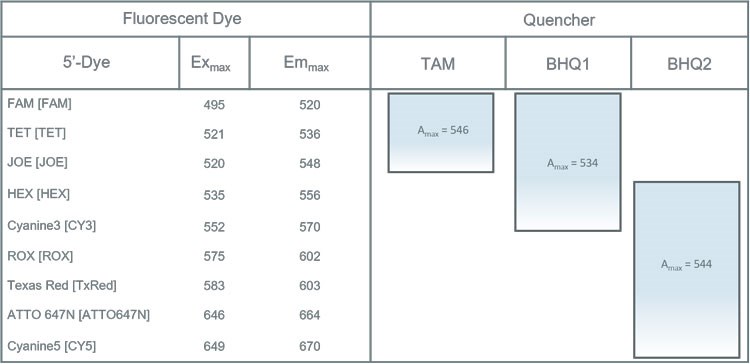
Product specifications:
- Average synthesis yields of 15 nmol resp. 2 OD
- Sequence length from 10 - 40 bases
- Up to 15 LocNA bases per probe are possible
- Only DNA bases are allowed at the 5' and 3' end
- HPLC purified by default
- Delivered lyophilized or concentration adjusted in tubes
- Production takes 10 working days
Molecular Beacons are hairpin-shaped hybridisation probes.
The sequence of these probes is designed to allow the formation of a hairpin structure in which the fluorescent dye and the quencher are in close proximity. The probe is designed to anneal between the PCR primers.

When the probe hybridises to its target sequence in the PCR annealing step, the loop opens and the fluorescent reporter and quencher are separated, resulting in a fluorescent signal upon excitation. The amount of signal is proportional to the amount of target sequence, and is measured in real time to allow quantification of the amount of target sequence.
Molecular Beacons can be ordered as Dual Labeled Probes.
LightCycler probes or FRET probes are hybridization probes based on the fluorescent resonance energy transfer (FRET) technique.
They consist of a pair of oligonucleotides (donor and acceptor) each labeled with a different fluorescent dye.
Donor and acceptor are designed to hybridise to adjacent regions in close proximity to each other on the target DNA. The acceptor probe is labeled with a fluorescent dye at the 5' end and the donor probe with fluoresceine at the 3' end. Interaction of the two dyes can only occur when both dyes are bound to their target.
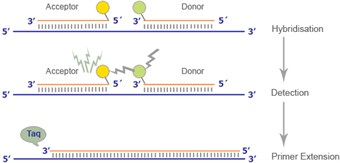
During FRET, the fluorescent donor molecule is excited by an external light source which subsequently transfers its energy to the acceptor fluorophore. The excited acceptor emits light of a different (longer) wavelength, which can be detected and measured.
Acceptor
| 5' Modification |
LC610, LC640, Texas Red, ROX, Cyanine5, Cyanine5.5 |
| 3' Modification |
Phosphate, Spacer C3 |
| Int. Modification |
2'-Deoxyinosine, 2'-Deoxyuridine
|
Donor
| 3' Modification |
Fluorescein |
| Int. Modification |
2'-Deoxyinosine, 2'-Deoxyuridine |
Please order these probes as Custom DNA Oligos >> here!
BHQ1 [BHQ1] 480-580 nm
BHQ1 is one of the Black Hole Quenchers from Biosearch Technologies, Inc. BHQ1 is a highly efficient dark quencher for Dual Labeled Probes, Molecular Beacons and FRET probes with an excellent spectral overlap for all dyes in the green to dark yellow emission spectrum.
| Quenching Range: |
480-580 nm |
| Max. Absorbance: |
534 nm |
| Molar Extinction Coefficient: |
34.000 M−1 cm−1 |
| Molecular Weight: |
491.5 g/mol |
BHQ2 [BHQ2] 520-650 nm
BHQ2 is the second Black Hole Quencher from Biosearch Technologies, Inc. in our portfolio. BHQ2 is a highly efficient dark quencher for Dual Labeled Probes, Molecular Beacons and FRET probes containing 5’ fluorophores in the dark green to orange emission sector.
| Quenching Range: |
520-650 nm |
| Max. Absorbance: |
544 nm |
| Molar Extinction Coefficient: |
91.000 M−1 cm−1 |
| Molecular Weight: |
493.5 g/mol |
BBQ 650 [BBQ650] 550-750 nm
The BlackBerry Quencher 650 is an excellent long-wavelength quencher for Dual Labeled Probes, Molecular Beacons and FRET probes containing long wavelength dyes such as Cy5, Cy5.5 and other dyes in the red to near-infrared emission spectrum.
| Quenching Range: |
550-750 nm |
| Max. Absorbance: |
650 nm |
| Molar Extinction Coefficient: |
41.000 M−1 cm−1 |
| Molecular Weight: |
575.6 g/mol |
Single-internal-quenched qPCR probes with enhanced quenching properties
Discover the perfect solution for your qPCR assays with our Ultimate Precision Probes.
The development of diagnostic qPCR assays shares many common challenges:
- The qPCR assay is not sensitive enough due to high background signals.
- The performance of individual assays in multiplexed assays is inadequate.
- The qPCR assay is not robust enough for all the different sample types you want to analyse.
- Extensive assay optimisation consumes valuable time and resources.
We are delighted to introduce the optimised Ultimate Precision Probes for addressing these challenges!
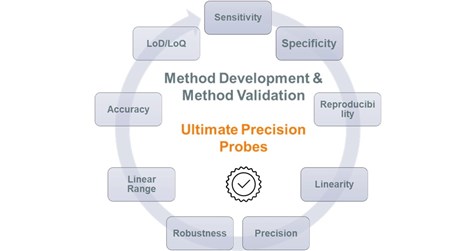
Ultimate Precision Probes deliver highly reliable, accurate and robust qPCR assay performance by following features:
DESIGN: Ultimate Precision Probes have 9 bases between fluorescent dye and quencher, compared to 20 bases in traditional probes. This results in high quenching efficiency and therefore low background noise and high-performance during PCR cycles.
PURITY: Due to our proprietary high-resolution HPLC purification, the probes have an extraordinary purity with positive effects on the linearity and efficiency of qPCR assays.
STABILITY: Phosphate at the 3’-end of the probe ensures robust probe stability during the entire life cycle of a probe during storage, pipetting and during the qPCR run. This ensures reliable results also for highly sensitive assays with a very low detection limit and a high number of cycles.